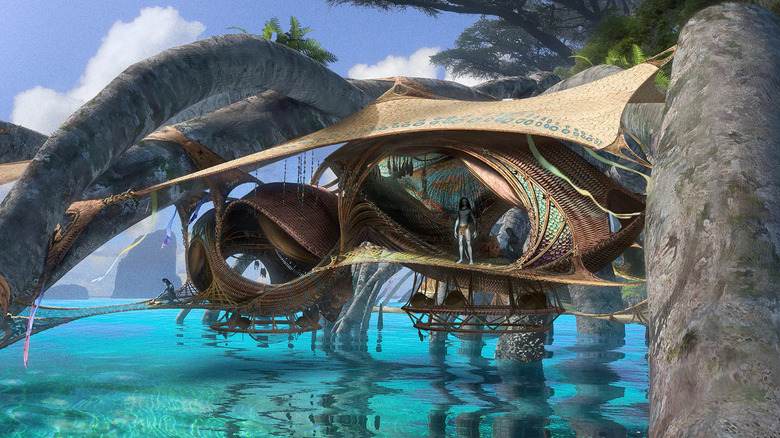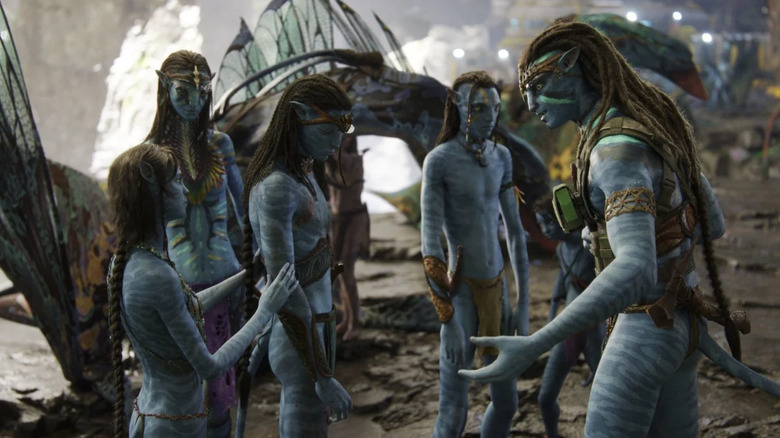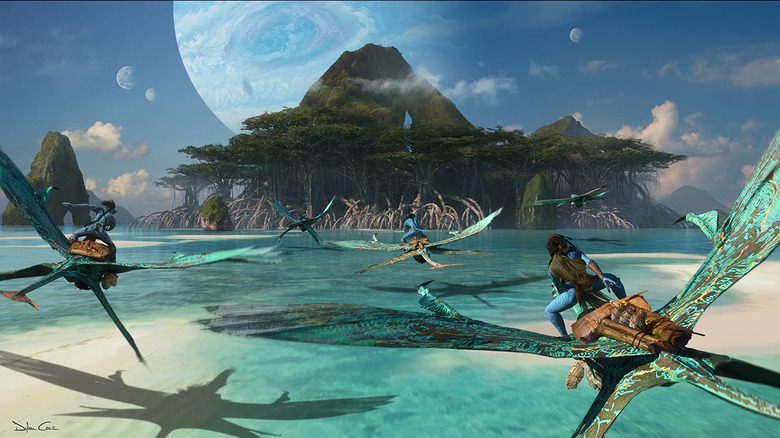The Metkayina Reef Village In Avatar: The Way Of Water Took Three Years To Get Right
In James Cameron's new sci-fi film "Avatar: The Way of Water" — already one of the 10 highest-grossing films of all time — our Na'Vi heroes Jake Sully (Sam Worthington) and Neytiri (Zoe Saldaña) have to move their family from the safety of Pandora's placid forests to a distant, tropical archipelago. There, they become the guests of the Metkayina, a tribe of Na'Vi that live in harmony with the oceans. The Metkayina can hold their breaths for an extended period of time, and their arms and tails have adapted for rapid swimming. Occasionally, they ride on the backs of flying ichthyosaurs, a sort of flying fish. The seas of the Metkayina are a beautiful biome of staggering alien diversity, and their villages are constructed of ropes, tents, and hammocks that hang tautly over crystal-clear lagoons from the branches of a strong, nearby tree. Like every visual aspect of the "Avatar" movies, the village is gorgeously realized.
Artist Dylan Cole was the production designer responsible for painting and actualizing the Metkayina water village, and his process took three years to finalize the setting. "The Way of Water," one might recall, was 13 years in the making, as the filmmakers wanted to ensure that every design and every special effect was darn near perfect before reaching audiences. Cole, who had also designed the look of the first "Avatar" in 2009, has also worked on films like "Transformers: Dark of the Moon," "TRON Legacy," "Oz: The Great and Powerful," Tim Burton's "Alice in Wonderland," and numerous other notable Hollywood blockbusters that required imagining larger, elaborate fantasy worlds.
In Tara Bennett's book "The Art of Avatar: The Way of Water," the author explains Cole's process in detail, including his deep dive into the works of architect Buckminster Fuller, and his school of Dymaxion design.
Dymaxion design theory
The word "Dymaxion" is, for architectural laypeople, a contraction of the phrase "dynamic maximum tension," which was Fuller's term for the practice of maximizing space and utility, while minimizing flourishes and materials. For Fuller, this meant a lot of curves, rounded edges, and oval interiors. Fuller's famous Dymaxion car looks a lot like a torpedo. Dylan Cole received instructions from James Cameron that read thus, "'You're building tensile structures and woven structures that are formed within. Let nature be your architect." Cole made an amalgam of Fuller and natural, tensile structures, incorporating a lot of bouncing, woven rope bridges and open-doored tent-like sleeping spaces.
According to Bennett, Cole's initial designs for the Metkayina village at large were too artificial for Cameron. Cole created a central "hub," where the tribe would congregate, with individual living quarters extended outward from it in concentric rings. It was, for those who are familiar, constructed somewhat like the tent layout for Burning Man. Cole describes Cameron's ultimate goals using the Japanese term marui (literally "round"), implying that the homes needed to grow more organically. It seems that the look of the Metkayina village was meant to look as natural as possible, more like birds' nests. Indeed, most cities don't begin as mapped out from the start. In real life, even the most complex urban centers tend to grow naturally.
The Sully family porch
After years of design, sketching, and experimentation, Cole finally figured that the walkways and the nests had to be organic outcroppings of one another. Homes and walkways were one and the same. They couldn't be merely functional. As Cole put it:
"Ultimately, we realized that we were thinking of maruis and walkways as two separate things [...] What really cracked the code for us was thinking of them as the same thing, where the walkway is part of the marui structure. It all flows together. We still needed big walkways but began thinking of them as units, which were illustrated in black-and-white sketches that designers Jonathan Bach and John Park were doing. And that really solved it."
Once the code was cracked as to how to make a natural, livable space for nine-foot, water-dwelling Na'Vi, a new, more practical problem arose: the script. Cameron, after all, didn't just need a village, but he needed to shoot scenes inside of it. That meant a cognizance of where different plot points would take place, and a cinematic visual dynamic to match each one. Cole now had to worry about where the camera was going to go, where people could stand and deliver lines, and more technical notions like focal length and photographic framing. Cole said:
"Jim was just like, 'No, where's my set? Where's my walkway? Where's my house? I need to shoot scenes! [...] I'm still trying to figure out what a reef village is, not what a set is yet."
It was back to the drawing board for Cole, who redesigned maruis to incorporate more characters. The Sully living space, for instance, had several scenes just outside its door. Cole endeavored to give the Sully family an ersatz "porch," allowing for Jake to talk to his kids as was laid out in Cameron's script.
The master builders
Builders were then brought in to actually construct physical models of Cole's designs. Ben Proctor and Kevin Loo were among the leaders of the building teams, and they put together miniature renditions of the sets that were then later built to scale by Ed Symon. The sets were, one might imagine, rather stripped down in real life, as so much of "The Way of Water" was to be realized in animated form. Actors walked around on Cole's and Symon's sets wearing specialized facial cameras and motion-capture suits, interacting only with what practical parts of the set were required. The actual sky, water, Na'Vi, and physical textures were a matter of complex animation.
Cole was impressed with the years of work, and was astonished once it was built and working. The maruis were real, and the Sully porch was practical. Seeing the finished film, Cole was just as astonished as most audiences would be. He said:
"I was literally teary because I was like, 'Oh my God, we have the reef village done!' I mean, it's never done, but this was our most difficult set to engineer. And we did it and then turned it over to Wētā FX."
In taking 13 years to make, it seems every detail of "Avatar: The Way of Water" was given as much care and attention as the sets. The result, a viewer will find, is one of the more impressive techincal feats of visual effects in cinema history.



